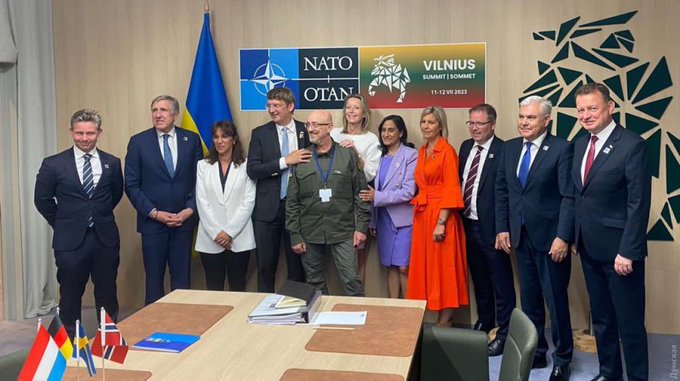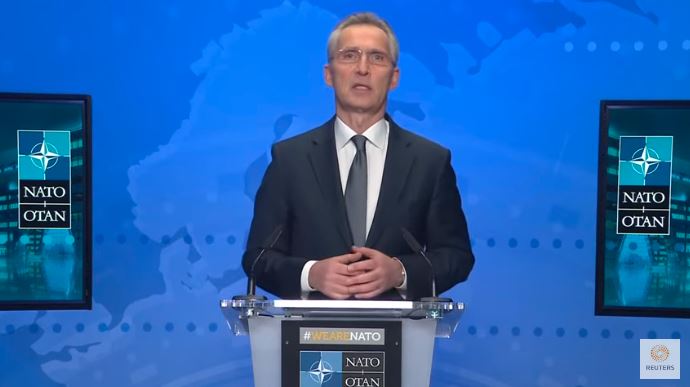Tension grows ahead of the upcoming NATO summit in Lithuania on 11-12 July: will the Alliance offer Ukraine a palpable path to membership, as Kyiv wants? Everything is possible, but this time, it is the USA holding back the decision.
For weeks, the participation of Ukraine’s President Zelenskyy in the summit was in the air. He said that he would not come if “leaders do not show “courage.” This would mean launching the procedure of Ukraine’s NATO membership, which was submitted to the Alliance on 30 September. Just on 7 July, NATO Secretary Jens Stoltenberg said that the Ukrainian president would physically attend.
Ukraine acknowledges that the country’s accession to NATO will not happen while it is in a state of war with Russia. Yet nothing prevents NATO from extending an invitation to Ukraine before the war ends. And achieving this invitation has become Kyiv’s main goal.
What NATO says it will give
NATO Secretary General Jens Stoltenberg has stated that the NATO Summit in Vilnius will bring Ukraine closer to joining the Alliance and announced a three-part package that the Allies intend to roll out:
- a multi-year assistance program “to ensure full interoperability between the Ukrainian armed forces and NATO”;
- establishing the NATO-Ukraine Council to “upgrade our political ties”;
- reaffirming that Ukraine will become a member of NATO.
The “reaffirmation” will follow NATO’s promise to Ukraine and Georgia that its doors are open at the Bucharest summit in 2008. However, no concrete Membership Action plan was offered to the post-Soviet nations.
Some analysts believe the Alliance’s hesitation to give Ukraine and Georgia a specific plan to join NATO prompted Russia’s invasion of South Ossetia and Abkhazia four months after the summit.
The NATO-Ukraine Council will serve as a window to Ukraine’s future membership, European NATO officials explained to the WSJ. According to the Journal, Ukraine will also have the authority to convene meetings of this council and ask for assistance, which individual member states can then provide.
What Ukraine wants
a) End of the “partnership era,” start of the “membership era”
Zelenskyy hopes to secure an invitation to the alliance for Ukraine in Vilnius.
Ukrainian officials underline they reject any proposals of a “new format” from partners, which will merely deepen the existing NATO-Ukraine relationship, in which Ukraine has been promised cooperation and support “for as long as it takes.”
“We don’t need any plans, targeted programs, and so on,” Ukrainian President Zelenskyy’s diplomatic advisor Ihor Zhovkva said. In the words of European Pravda editor Serhiy Sydorenko, Kyiv aims to wrap up the “era of support” and start the “era of membership.”
This era will not be completed before Ukraine finishes the war against Russia. But it should definitely start, says Zhovkva.
What does Ukraine expect in Vilnius? The exact formulations of Ukraine’s document that has been sent to all NATO representatives are not known, but the general requests are clear:
- Ukraine insists on an accelerated algorithm that was recently applied to Sweden and Finland — NATO accession without a Membership Action Plan. Support for this scenario has been recently growing among NATO members.
- Kyiv agrees that Ukraine’s accession to NATO will not be quick. Various scenarios are considered, for instance, when the invitation in Vilnius will be considered “political” and approval of Ukraine’s NATO membership will be finalized during the 2024 summit in Washington.
- The final decision on Ukraine’s NATO membership could be made “when security conditions allow.”
b) Security guarantees
A parallel track of Ukraine’s work in NATO is receiving security guarantees from NATO partners before it becomes a member state.
The outlines of these security guarantees were drafted in the Kyiv Security Compact, presented in September 2022 by Ukraine’s Presidential Office Chief Andrii Yermak and former NATO Secretary General Anders Fogh Rasmussen.
The proposed agreement would grant Ukraine priority access to arms transfers and advanced technology while enabling Ukraine to summon council meetings and seek assistance. The United States would serve as the primary guarantor of these security arrangements, working alongside European NATO members.
The exact countries that would provide such guarantees have not been named, but FAZ reported that the framework agreement for such guarantees with Germany, France, the UK, and the US was nearly ready.
“Security commitments” for Ukraine: preventing a Budapest Memorandum-2
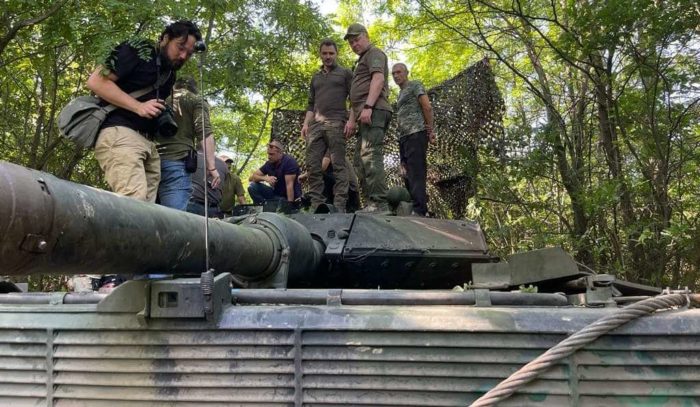
The security guarantees, which Polish President Duda and US President Biden described as “Israeli-type,” would provide Ukraine with weapons and the ability to defend itself. The American President stated that Ukraine could receive such security guarantees “if there is a ceasefire, if there is a peace agreement.”
As per German Chancellor Scholz, they would apply to a “peaceful time” after Ukraine’s victory to prevent Russia’s repeated aggression.
However, when this time would arrive is unclear, as Russia is unlikely to stop firing missiles into Ukraine even after it retreats from Ukrainian lands. Or, if Ukraine agrees to a lengthy ceasefire, does this mean that this war “stopped” and peace has started?
Some capitals see these “security guarantees” as an alternative to Ukraine’s membership. This potentially could be a security solution if they would be real security guarantees akin to the bilateral agreements signed between the USA and Japan or South Korea in the 1950s.
However, the “security commitments” currently being reviewed by the USA, France, Germany, UK, with the potential involvement of all G7 members and Ukraine’s western neighbors (particularly, Poland), have nothing in common with real security guarantees, says Ukrainian analyst Alyona Hetmanchuk.
At best, they involve guarantees of long-term security support, but even this option is in question.
A real risk exists that the new formulations could be even vaguer than the infamous security commitments of the Budapest Memorandum, Hetmanchuk says. Through this deal, signed in 1994, Ukraine relinquished its nuclear arsenal in exchange for “security assurances” from the USA, the UK, and Russia. The hazy wording of these assurances, however, resulted in Ukraine being left to stand on its own against the Russian invasions in 2014 and 2022.
Moreover, the discussion about the commitments could “blur” the debate on Ukraine’s NATO membership, which is the only thing really capable of deterring Russian aggression, Estonian Prime Minister Kaja Kallas warned.
According to her, the proposed commitments are based around codifying and pledging a long-term continuation of support that Ukraine is already receiving from its allies.
“This is what we are doing right now, but it doesn’t give you any other additional guarantees. The war will not be there when the deterrence is credible,” she told Financial Times.
Other politicians from the Baltic states support Kallas’ position. Linas Linkevičius, former Lithuanian foreign minister, also says:
“I don’t want Vilnius to be remembered as a mistake. There is no alternative to NATO. Ukraine needs security guarantees, not fake ones, not another Budapest memorandum.”
Linkevičius stresses that the buffer keeping Ukraine at a distance from NATO must be removed.
“Everything else, even the transformation of the NATO-Ukraine Commission into a council, is political cosmetics. You can try to sell it as some kind of result. But, speaking frankly, I don’t believe in it.”
USA is the main obstacle
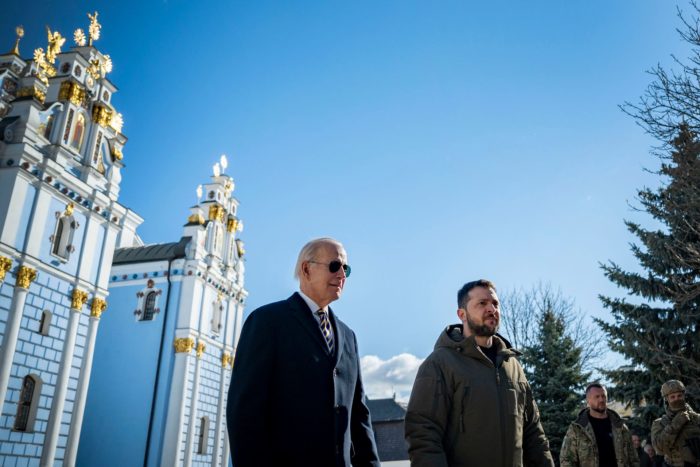
While the United States was the main “driver” of Ukraine receiving the fateful promise of NATO’s open doors at the Bucharest summit in 2008, today, it is the main obstacle to Ukraine’s invitation to the Alliance, writes head of the New Europe Center Alyona Hetmanchuk.
According to the foreign affairs expert who returned from a tour to lobby for Ukraine’s accession to NATO, France and Germany are no longer opposed to extending an invitation to NATO. These countries were the skeptics back then in Bucharest, where they blocked a Membership Action Plan for Ukraine. However, Russia’s full-blown invasion deprived them of their main counterargument: the threat of a possible escalation should Ukraine be invited to NATO.
Security experts both in France and Germany are confident that neither country would block Ukraine’s membership invitation if Biden gives the green light. Neither is Hungary expected to veto the decision if the United States says yes to a NATO invitation for Ukraine.
This is why President Biden has become the focus of special attention ahead of the summit. President Zelenskyy has called on him to invite Ukraine into NATO now, even if membership does not happen until after the war.
Unfortunately, President Biden has not expressed readiness to extend the invitation just yet.
The White House issued a statement that Ukraine needs to undergo reforms to meet the same standards as any NATO country before joining the Alliance. Kyiv responded that the West should rather reform its attitude to Russia.
Speaking with CNN, Biden repeated the same idea: that there needs to be a “plan” that would pave “a rational path” for Ukraine to “qualify” to join NATO because that is a “process that takes time to meet all the qualifications, from democratization to a whole range of other issues.”
This appears to be more an excuse than a legitimate request if we are to believe Alyona Hetmanchuk: reforms as an obstacle to NATO membership were not named in any European capital, apart from fears that reforms democratic civilian control over the army could slow down due to martial law. However, Ukraine launching its NATO membership process could actually accelerate this reform. On the contrary, it could be stalled in the absence of progress, leading to a million-strong combat-capable army with a huge amount of arms in the grey zone and with no democratic control after the war, Hetmanchuk says.
Arguments and counterarguments
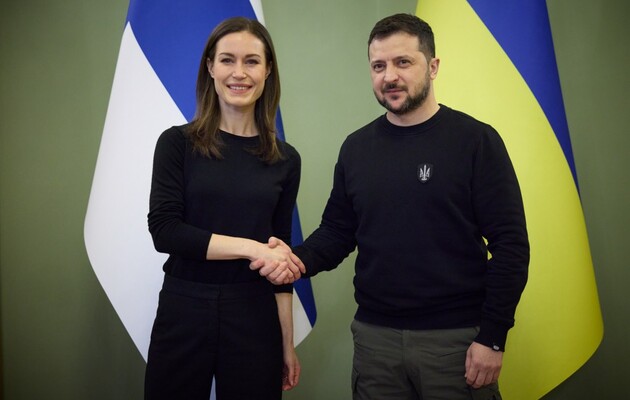
According to Alyona Hetmanchuk, Italian politicians and officials acknowledge that Ukraine deserves NATO membership but believe that insisting on it at this stage is counterproductive because “the Alliance is too divided” and are convinced that this step will lead to an even greater escalation of the war with Russia.
However, it is the Alliance dawdling on inviting Ukraine that is likely to create an escalation, not the other way around, as this will increase anti-NATO narratives inside and outside Ukraine, as well as show NATO as an “Alliance that is afraid of Russia.” Moreover, the invitation of Sweden and Finland did not result in an escalation from Russia. Furthermore, Ukraine’s non-aligned status did not stop Russia’s first invasion in 2014, and the absence of any NATO invitation for Ukraine did not prevent Russia from its full-scale invasion. History shows that Russian aggression cannot be managed by NATO timidity.
The Germans believed that NATO cannot invite a country to the Alliance if it does not understand what borders it will have after the war — a direct reflection of some Western capitals losing hope that Ukraine could liberate all its lands, Hetmanchuk says.
Meanwhile, skeptics in Paris questioned NATO’s capability to defend Ukraine in case of Moscow’s next attack, considering the length of its border with Russia. They were also worried whether Putin would see Ukraine’s invitation to NATO as confirmation of the idea that the Alliance “threatened” Russia, a myth Putin used to justify his invasion of Ukraine.
However, Ukraine is already doing a good job of defending itself with the help of the Alliance’s equipment, ammunition, and training. However, its counteroffensive is stymied by insufficient materiel and Western vacillations about delivering crucial attack gear such as tanks, long-range missiles, and jets. Had Ukraine received them immediately, given that NATO would have been prioritizing its defense expenditures, Russia would have been defeated long ago.
Moreover, one of the reasons Russia does not dare attack the Alliance is because it knows it is technologically inferior. Ukraine becoming part of the Alliance will act to deter Russian aggression, meaning that Moscow’s next attack will not happen. Additionally, Ukraine will strengthen the Alliance significantly, boosting Euroatlantic security, as it is the only country having experience fighting Russia’s army.
Meanwhile, it appears that the most potent counterargument is that Ukraine’s invitation to NATO would remove once and for all the option of Ukraine’s neutrality that, according to some diplomats, could be one of Kyiv’s compromises at the negotiating table with Moscow. This is the most likely reason, along with the fear of further escalation, why countries like the USA refuse to consider concrete steps to invite Ukraine to join the Alliance, Hetmanchuk says.
However, Ukraine was a neutral country in 2014, when Russia first launched its long war. Since then, most Ukrainians have come to reject neutrality for the country resolutely, seeing NATO membership as the only path to security.
Presently, 89% of Ukrainians want their country to become part of NATO, a KIIS poll showed in late June 2023. It is unthinkable that Ukrainian society would accept any deal of “neutrality.” Moreover, this neutrality will do nothing to deter Russian aggression.
Scenarios of NATO membership for Ukraine before it wins the war
Contrary to common belief, NATO has a track record of accepting states with occupied territories, as seen in the case of West Germany during the Cold War. It has no explicit restrictions against admitting countries in times of war. In fact, political invitations are seen as the first step in a process that can lead to membership. And several Western experts are already exploring how Ukraine might be ushered into the Alliance before all its territories are liberated and a “peace” is established.
The Atlantic Council’s Ian Brzezinski suggests that NATO could extend its security guarantee to the territory Ukraine controls at the time of its accession, similar to the case of Germany when it joined the Alliance while a third of its territory was controlled by the Soviet Union. He states, “Establishing an Alliance force posture to credibly deter Russian aggression against Ukraine will be far less financially onerous than reinforcing and sustaining Ukraine’s defenses and rebuilding its economy under perpetual wartime conditions.” He believes that granting NATO membership to Ukraine is the most unambiguous way to demonstrate to Putin that suborning Ukraine is unachievable and wasteful.
On the other hand, if NATO does not take in Ukraine, the author warns of dire consequences. He argues, “If the transatlantic community consigns Kyiv to the Israel model, Ukraine will be left indefinitely in the gray zone of insecurity that has repeatedly catalyzed Putin’s hegemonic ambitions into violent actions.” He further suggests that Ukraine might consider developing its own nuclear arsenal, as Israel did, in response to the ongoing threat. He concludes, “As long as NATO is not fully committed to defending the security of Ukraine, Putin will continue his violent quest, especially if he believes continuing the conflict is the key to preventing Ukrainian membership in the Alliance.”
Similarly, Fredrik Wesslau of the Stockholm Center for Eastern European Studies proposes a three-pronged approach for NATO to practically accept Ukraine amidst the ongoing conflict.
- He suggests that NATO allies should commit to a roadmap that sets out a clear and accelerated process for Ukraine to become a NATO member. This roadmap should not set conditions for membership but rather provide a political path to membership. He writes, “The roadmap should set out how NATO Allies can provide practical support to Ukraine in moving forward along this roadmap. The roadmap should not set out conditions for membership but rather provide a political path to membership.”
- Wesslau proposes a geographically limited application of Article 5, NATO’s mutual defense clause, as a temporary measure while the war is ongoing. He suggests that Article 5 could initially cover the territory west of a Kherson-Dnipro-Kharkiv axis, based on the current contact line. He states, “Article 5 with geographic limits would not entail ‘giving up’ on eastern Ukraine or de facto accepting a Korea-style division of Ukraine. Such an arrangement should make sure to not indirectly legitimise Russia’s control over the east.”
- Lastly, the author suggests that NATO membership for Ukraine could be preceded by an interim commitment by a coalition of key states to use air power to protect western Ukraine. He writes, “The coalition could, during the interim period before NATO membership, provide partial security guarantees by committing to defending Ukraine with air strikes on Russian military targets inside Ukraine in case of a new land attack west of a Kherson-Dnipro-Kharkiv axis.” This commitment would effectively establish a “land force exclusion zone” in western Ukraine, deterring Russia from launching a new land invasion.
Related:
- Ukraine retains NATO aspirations in new treaty for security guarantees
- NATO countries may offer Ukraine Israeli-type security guarantees – WSJ
- France offers security guarantees to Ukraine, affirms commitment to support
- NATO’s Vilnius summit will unite Alliance behind Ukraine and bring it closer to NATO – Stoltenberg
- US supports Ukraine’s accession to NATO when Ukraine meets all requirements – WH
- Ukraine will get “a lot” at NATO summit, but not as much as expected – Lithuania President



